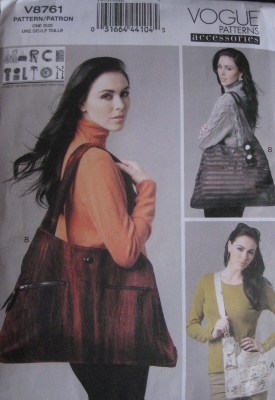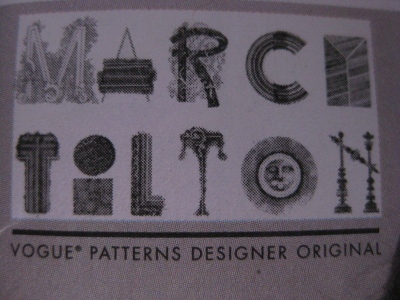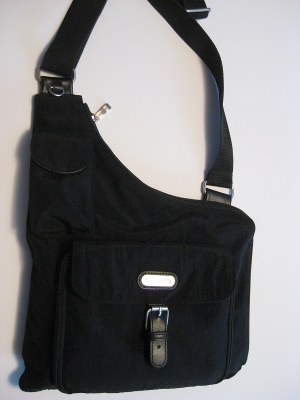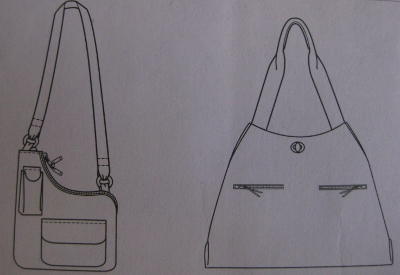Have you seen this new Marcy Tilton pattern, Vogue 8761?
Have you ever noticed the logo in the upper right corner? It’s Marcy Tilton’s logo:
If you can’t read the small print under, it says “Vogue Patterns Designer Original”. Vogue, and Marcy Tilton, want you to know that you’ve just paid for something special: an original design by a “designer”. This is (allegedly) something you can’t get anywhere else.
On the back of the pattern, you can see this:
It says: “SOLD FOR INDIVIDUAL HOME USE ONLY AND NOT FOR COMMERCIAL OR MANUFACTURING PURPOSES ONLY.” There’s a copyright notice above this line; that means that Marcy Tilton and Vogue own this design, and no one else can profit from it.
Well, that seems fair, doesn’t it? Marcy Tilton (and Vogue) are selling you the right to make items from this pattern just for your own personal use.
They are reserving the right to make money off this design, because it’s their own, original design. Marcy Tilton has put sweat, effort, and presumably, development expense, into designing this pattern so that she can sell it, first to Vogue, and then to you.
EXCEPT . . . EXCEPT that when I bought this pattern, I was wearing this bag, which a fantastic company named Baggallini has sold for years:
This is the Baggallini Uptown bag. That shiny plate on the front says “Baggallini”.
And, at that moment, at home in my closet, was this bag:
(Yeah, all rumpled. It didn’t know it was going to get its picture taken today.)
This one’s my favorite Baggallini bag of all time, the Milano, which Baggallini was selling a long time before this Tilton pattern became available this month.
Baggallini is an interesting company. It was started by stewardesses who wanted better purses for travel. You know, just people who had a good idea and thought they might grow a business from it. Kind of like what a designer might do, too, when starting out — imagine things, create them, and grow a business.
At first, Baggallini offered very utilitarian bags, but in recent years, they’ve gotten more adventuresome, and now offer new, more fashionable, lines. The Milano, above, is from their trendiest, the “International Collection”. Apparently, it’s catching quite a few eyes.
Here’s the line drawing for the Tilton pattern:
The differences between the Tilton “designs” and the Baggallini bags are inconsequential. Vogue/Tilton have even used exactly the same, somewhat unusual, closure for the view B bag as the one that is sold on the Baggallini Milano.
These two bags in the Vogue pattern are not “original” in any sense of the word. The “designs” were Baggalini before they were “Tilton”.
Although both Tilton and Vogue license this pattern under terms that do not allow you to profit from their work, they apparently, have no problem profiting from someone else’s labor and development, themselves. They just don’t want to be the ones ripped-off.
Nothing in the pattern, on the Tilton site, or on Vogue’s site, indicates that this pattern is authorized, or licensed, by Baggallini.
This is a particularly interesting situation since it calls into question the value of the Marcy Tilton brand. What kind of “designer” offers previously marketed work and repackages it as his or her own?
Any one of us might buy a Baggallini bag and copy it. Home stitchers do this, or some variation of it, all the time. BUT IF THEY ARE ETHICAL PEOPLE, THEY DO NOT SELL PRODUCTS MADE FROM OTHER’S DESIGNS. And this isn’t a case of someone making one of something for personal use; it’s a case of a “designer” selling something that looks virtually identical to something already on the market, made by another company entirely. And backed by a major publishing house.
This example is particularly interesting, too, because not one, but TWO, unoriginal designs are sold in this pattern envelope — both, seemingly, from the same source.
Marcy Tilton is not a home sewer; she is a person who has made her name, and her livelihood, on theoretically original designs that she creates. When you buy a Tilton pattern, you are buying Marcy Tilton’s “vision”, her aesthetic: Something, theoretically, you can’t find elsewhere. Except, it seems, when you can.
It makes me wonder if somebody saw all those Etsy sellers getting ripped off, and decided that, really, it was OK to lift whatever would sell, because who, really, would notice?
I did. I have a closet full of Baggalini bags, and I love them. I buy them because they are clever, stylish, and easy to wear and use. Apart from ethical and legal considerations, Baggalini deserves more respect than this.
And there’s that other nagging question: Why design at all if you can just take what others have already done and claim it as your own?
If there’s a good explanation for this I’d just love to hear it.
Update 7/18/2011: A reader has written to let me know that there is a link to Baggallini on Tilton’s website. Tilton recommends the Baggallini Rolling Tote on her “Life Tools” page.
This confirms that Tilton is familiar with Baggallini products.
The mystery regarding the release of two designs that so closely mirror Baggallini’s, under the Tilton name, without any mention of Baggallini, still baffles. It’s odd that the designs are so obviously similar, yet no explanation is offered. This seems a strange choice when the lack of an acknowledged link is virtually guaranteed to raise questions.






Your well-thought-out position on “professional copying” gives me hope. I’m a seamstress of 40+ years as an occupation.
I’ve been asked to duplicate everthing from the Polo rider, to a complete set of Vogue designer wardrobes. Not one person would accept my explanation that it is illegal as a reason for refusal. The one who had the Vogue patterns was a fashion design student and was so contemptuous that I verbally frog-marched her to the door, after the following, “You ARE going to do this. Don’t be silly, I will make a lot of money and you will get paid.” According to her, this was the way things were done in her country. Glad I don’t live there.
What a fascinating comment, nehmah. Thank you for sharing your experience and perceptions. Thanks, too, for remaining true to your values, and giving hope to the rest of us who feel similarly! I like to hope that karma eventually catches up with people like your design student; some people just don’t get the concept that integrity might be a whole lot more important than money.
I’m not at all saying that Marcy Tilton should be let off the hook on copying because she’s originally a home sewer. I’m saying that you have no idea what agreement she may have with Groom, the -original- designers, seeing how she’s got a good enough relationship with them to be the only distributor in the US (as far as I know) of their finished bags. That she wouldn’t credit someone who not only appears to have copied Groom themselves but is in direct competition with them (selling bags and not just pattern instructions) should not be too surprising.
In short, as a home sewer you don’t know what industry relationships there may be behind what you’re seeing. As well as not having complete information since you believed that Baggellini had created totally original designs for the bags they sell. If you think there’s something untoward happening, the appropriate response would be to contact Baggellini privately and let them know that you think their designs are being copied. And then not to hound them for an answer, as they may very well want to drop the topic, considering :-).
Besides the very good discussions of what ‘copying’ means and all its ramifications on fashion-incubator.com (from the point of view of professionals), do you remember the discussions a couple years ago on fehrtrade about large pattern companies copying not only designers (not always with attributions) but each other? Singling out Marcy for complaints rather than the larger companies just seems.. a bit unbalanced of a reaction.
Marie-Christine, I’ve said both in the post and in my earlier response to you, that we do know what are the relationships, if any, in this case.
Any private response I, or any one else, receives does not address my primary concern: That by appending her name (and brand) to such an egregious example serves very much to condone exactly that behavior. For someone with a recognized name to do this without public explanation of attribution or the relationships involved amounts to not only condoning the act, but encouraging it. That we don’t know the relationships is exactly the issue.
If this is a direct copy of a Groom bag, would you please provide a link? There is nothing currently on their website that resembles either of the “Tilton” bags, and, although I have not watched the Groom site on a consistent basis, I cannot recall ever having seen any bags of theirs that closely resemble the ones we are discussing.
The fact that you yourself describe her unwillingness to attribute the source as “not surprising” does not make it ethical. This particular example isn’t one where a designer used another model for inspiration; the bags are virtually identical.
This isn’t a matter of singling Tilton out; it’s a bringing to light a particularly blatant example of something that many people do not feel serves the design community well.
I can see why you find all this disturbing. But maybe it’s not all that can be seen at first glance?
The Baggallini Milano for instance is strongly reminescent of a Groom bag from several years back http://www.groomparis.com/ Groom makes very expensive very good quality leather bags, very cleverly designed, and was an early French designer to make good lightweight nylon bags, not to mention to routinely include cell-phone pockets. Marcy Tilton also sells them now on her site, for completeness of information’s sake. I’ve used them for decades because I found them much more functional than most women’s handbags.
While I’m all for small companies run by 2 ex-flight attendants, and wish them all the best, don’t you think it may be likely that they started this successful company not only because they got to test the various models in their travels personally, but also because their job gave them access to a much wider sample of products from other countries?
From what I see of Baggallini’s bags, what makes them unique isn’t really the designs, which are found pretty much everywhere in the same shape. It’s their good quality, their light weight, their range of colors, and most of all their clever pocket design. Most of that seems to be lost in translation to a sewing pattern (I see no indication of specific pocket design in the Vogue?).
Also, I don’t see much real competition from Vogue to Baggallini, honestly :-). How many women really make their own daily bags? Who wouldn’t buy one instead or as well if they found one that truly suited them? There’s behind all that the crucial issues of quality and price. For that I’d refer to you to fashion-incubator.com’s many excellent posts on copyright issues in ready-to-wear, which has real insider insight on why and how copying happens.
I don’t mean to defend copying just because it would come in this case from Marcy Tilton, a person I’ve always had good experiences with and who runs her businesses in a quite ethical manner in general. It is good if she’s pointing people to Baggallini as a good source of bags from her site (potentially impacting her Groom-importing business, but clearly she sees the difference). But you can see how if Vogue knew that Baggallini were themselves manufacturing very good but not-quite-original bag designs, their lawyers would object to putting credit to them on their pattern envelopes? And you shouldn’t also overlook that what one buys in a pattern isn’t entirely the design, but most importantly the instructions, and those you can be sure are both good and written by Marcy herself.
I will say though that dismissing Marcy offhand as ‘not a home sewer’ is both irrelevant and inaccurate. She’s a home sewer who’s made good, a home-ec teacher who founded the Sewing Workshop which taught thousands of people to sew (better, with more modern methods, with higher expectations) in San Francisco, and contributed strongly to the revival of sewing in recent times. She’s branched out into various things since moving to Oregon, including some designing for Vogue. But that’s not principally how she ‘made her name’, her excellent teaching did that. She’s quite as much a model of scrappy successful self-made business woman as 2 flight attendants, actually :-). And of course she continues to sew for herself through it all. So let’s not get too carried away, OK?
Marie-Christine, thank you for such a thorough and well-thought-out response. I think that what I find of great concern in this particular instance is that it seems to me that when someone as well known as Marcy Tilton allows something this blatant to appear, without any reference to existing models, she is essentially validating these acts, either because she does not expect to be called out or because she feels that she is powerful enough to do as she wishes without consequence.
In my opinion, by failing to attribute her design, Tilton is using the power of her brand to say that blatant copying is just fine. I’m not alone in feeling that it is not.
As far as the Vogue/Baggallini/Tilton relationships, or lack thereof, we really don’t know. What we do know is that Tilton has chosen to avoid publicly acknowledging the obvious similarities of her “original” design to one already sold by someone else.
I know, too, that, as of two days ago, this pattern was no longer available on Tilton’s site, so perhaps she’s had second thoughts.
I think that the fact that Tilton is no longer any kind of home-sewer is relevant, however, as her influence far exceeds that of a home sewer. With power comes responsibility. That’s part of what makes an ethical business, ethical. Where she began is interesting, but it’s no excuse for what comes after.
Is it really all right to say that “so-and-so has done a lot of good, so let’s overlook this bit of cheating”? In an era when there is so much discussion about copying it’s a real pity that “designers” like Marcy Tilton, who are truly talented and have the ability to stand on their own, aren’t proving to be leaders in standing up for truly original works.
Let’s face it, it’s not that hard to tweak a design and make it something different. That’s what designers do all the time, but that’s not what happened here.
Wow, I hope either someone from Marci Tilton or Vogue responds to you about this. I’m hoping that Marci actually designed the bags for Baggallini in the first place. Otherwise, that’s just tacky to acknowledge you know of the company and then directly steal their design.
Yes, if there were a prior association, it’s very odd that that hasn’t been made clear, since failing to mention it only suggests all the wrong things. It’s very peculiar, especially when there has been so much public discussion lately about the ways in which designs have been misappropriated.